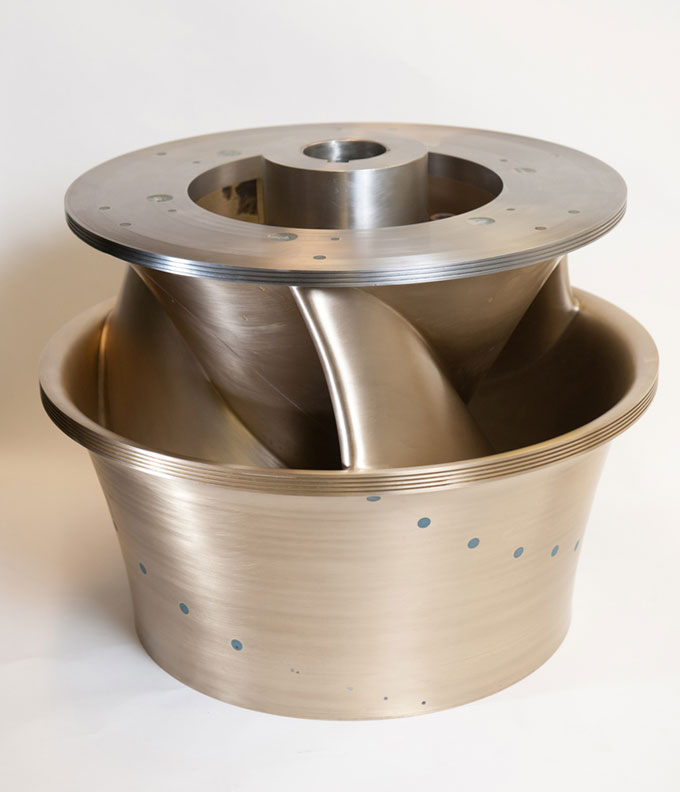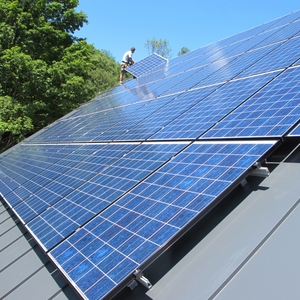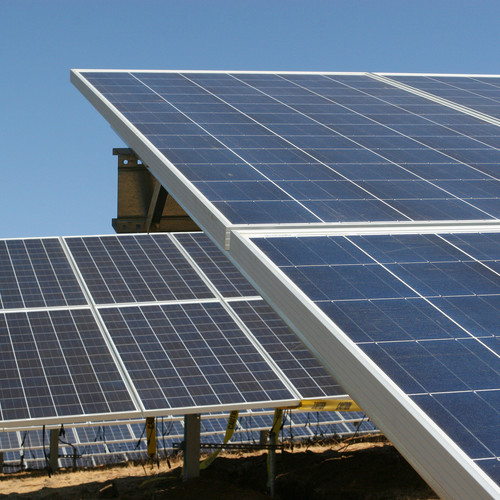Image Credit: EPRI
Image Credit: EPRI Semiconductive nanocrystals allowed Berkeley researchers to develop an adjustable electrochromic coating, a breakthrough that could really put the smart in “smart windows.”
Image Credit: LBNL Agilyx’s resource recovery technology converts difficult-to-recycle plastic into synthetic crude oil.
Image Credit: Agilyx This piece of foam, coated with very thin layers of clay and chitosan, remained soft and did not ignite or melt during laboratory burn tests. Researchers hope such renewable coatings might one day replace brominated flame retardants.
Image Credit: Galina Laufer
An environmentalist dies and reports to the pearly gates, but there is a mix-up and she is sent to the gates of hell. Once in hell, she is horrified by the air and water pollution, global warming, and habitat destruction. But she gets to work to improve the situation, and soon the hellscape is covered with grass and plants, the food is organic, the air is clean, and the people are happy.
One day, God calls Satan up on the telephone and says with a sneer, “So, how’s it going down there in hell?” Satan tells God about the improvements brought by the environmentalist, and God says, “What? You’ve got an environmentalist? That’s a mistake — send her up here or I’ll sue.” Satan laughs and answers, “Yeah, right. And just where are you going to get a lawyer?”
It takes all types to deal with our environmental problems — and today I’d like to focus on the researchers who are toiling away in laboratories, trying to eke out greater efficiencies from technologies that most of us never give any thought to. Here are some recent highlights that I have dug up.
Windows that allow in light but not heat
Researchers at Lawrence Berkeley National Laboratories have developed a technology that reduces solar heat gain without blocking visible light, allowing for “smart windows” that can respond to outdoor conditions without a visible change in the window. At present, electrochromic window coatings can block near-infrared radiation, which causes heat gain, but only by darkening the window at the same time; this can lead to increased use of indoor lighting and offset the energy benefits of smart windows.
The new technology uses a transparent “nanocrystal” coating of indium tin oxide — a semiconductor used in flat-screen TV displays. The coating could allow for the creation of smart windows programmed to work in tandem with ventilation and lighting systems by selectively allowing heat to pass and always allowing light to pass — thereby reducing heating, cooling, and lighting loads.
A new way to generate solar electricity
Researchers in applied physics at the University of Michigan have discovered a method that uses the magnetic component of light to generate electricity without using semiconductors or photovoltaic (PV) panels.
When the electromagnetic waves in light passes through certain transparent materials, the magnetic waves are amplified, causing electrons to move away from their nuclei, and creating a static electric field. Conductive materials can be placed on either end of the transparent material to collect the voltage generated across the field, a method that could potentially achieve close to 100% conversion efficiency, because it does not rely on the heat-creating light absorption that limits efficiency of PV panels. The researchers have applied for a patent and are currently investigating suitable transparent materials to use in further experiments.
Converting waste plastics into crude oil
Oregon-based alternative energy start-up Agilyx says it has developed a system to convert difficult-to-recycle discarded plastics into synthetic crude oil. The technology has been in development for a year and a half, and the company predicts that it will be ready for commercial applications in mid-2012.
The system vaporizes the plastics and then condenses the vapor into oil. The modular system currently under development, according to the company, will be capable of converting 10,000 pounds of plastic into 60 barrels of synthetic crude oil a day. Once the technology is developed, Agilyx plans to sell the modules to trash companies, which would own and operate the machinery and sell the synthetic crude oil to refiners.
Technologies like this one, dubbed “resource recovery,” are becoming increasingly attractive as solid-waste stockpiles grow and extraction of virgin materials becomes more costly. Agilyx predicts that its systems will provide owners a 25% rate of return on their investment, and major players in the trash industry, such as Waste Management, have already invested in the company.
A natural replacement for toxic flame retardants
Alternating layers of clay and chitosan (a polymer derived from crustacean shells) have shown promise as a possible flame retardant in lab tests at Texas A&M University. When applied to foam and exposed to a direct flame for ten seconds, the coating formed a protective thermal barrier that kept the foam from igniting or melting — giving researchers hope that coatings made from renewable materials could eventually replace toxic brominated flame retardants (BFRs), which are ubiquitous in consumer items.
Unlike BFRs, which chemically disrupt a fire that has already begun, this coating is designed to prevent ignition, Grunlan explained. Chitosan between the clay layers does flame up briefly, but the clay quickly “collapses,” he said. “The polymer gets eaten out by heat and fire initially, and what’s left behind is a layer of clay-rich coating which acts as a heat barrier.”
Hydropower that’s safer for fish
The Electric Power Research Institute (EPRI) has received $1.5 million from the U.S. Department of Energy to field-test a new hydroelectric turbine developed by research engineers at Alden Research Laboratory. The turbine is designed to maximize the use of hydroelectric resources without further jeopardizing migrating fish populations.
Preliminary testing indicates that the Alden turbine can maintain high efficiencies while allowing fish migrating downstream to pass with a 98% survival rate; upstream migration issues must be addressed separately with other mechanisms, such as fish ladders.
Instead of the six or more blades common in older turbine designs, the Alden turbine has only three blades, reducing the chance that fish will be struck by a blade. The blades also have a semi-round edge, which pushes enough water in front of the spinning blades to move the fish out of their path.
If the Alden turbine proves successful in field tests, it could open the door to maximizing the use of hydropower resources currently being lost to dam spillover and through-fish bypasses meant to protect migrating fish populations. Researchers estimate domestic hydropower capacity lost to fish protection measures to be as much as 25,000 megawatts.
Have you seen some cool research items? Let me know!
Thanks to my colleague Evan Dick for his work in compiling some of this information.
Tristan Roberts is Editorial Director at BuildingGreen, Inc., in Brattleboro, Vermont, which publishes information on green building solutions.
Weekly Newsletter
Get building science and energy efficiency advice, plus special offers, in your inbox.
















0 Comments
Log in or create an account to post a comment.
Sign up Log in